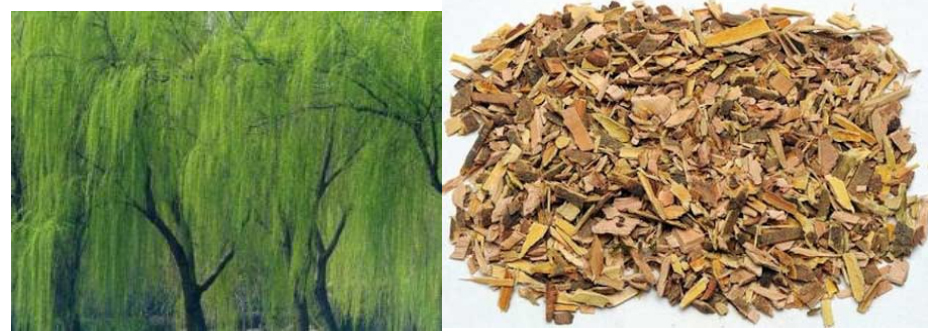Factory Supplier for White Willow Bark Extract Supply to Mozambique
Factory Supplier for White Willow Bark Extract Supply to Mozambique Detail:
[Latin Name] Salix alba L.
[Plant Source] from China
[Specifications] Salicin 15-98%
[Appearance] Yellow Brown to White powder
Plant Part Used: Bark
[Particle size] 80 Mesh
[Loss on drying] ≤5.0%
[Heavy Metal] ≤10PPM
[Storage] Store in cool & dry area, keep away from the direct light and heat.
[Shelf life] 24 Months
[Package] Packed in paper-drums and two plastic-bags inside.
[Net weight] 25kgs/drum
Brief Introduction
Salicin is a naturally occurring compound found in the bark of several species of trees, primarily North American in origin, that are from the willow, poplar, and aspen families. White willow, from whose Latin name, Salix alba, the term salicin is derived, is the most well known source of this compound, but it is found in a number of other trees, shrubs, and herbaceous plants as well being synthesized commercially. It is a member of the glucoside family of chemicals and is used as an analgesic and antipyretic. Salicin is used as a precursor for the synthesis of salicylic acid and acetylsalicylic acid, commonly known as aspirin.
A colorless, crystalline solid in its pure form, salicin has the chemical formula C13H18O7. Part of its chemical structure is equivalent to the sugar glucose, meaning it is classified as a glucoside. It is soluble, but not strongly so, in water and alcolhol. Salicin has a bitter taste and is a natural analgesic and antipyretic, or fever reducer. In large quantities, it can be toxic, and overdoses may lead to liver and kidney damage. In its raw form, it may be mildly irritating to skin, respiratory organs, and eyes.
Function
1. Salicin is used to ease pain and reduce inflammation.
2. Relieve acute and chronic pain, including headache, back and neck pain, muscle aches, and menstrual cramps; Control arthritis discomforts.
3. Relieve acute and chronic pain.
4. It has the same effect on the body as aspirin without any of the side effects.
5. It is an anti-inflammatory, a fever reducer, an analgesic, an anti-rheumatic, and an astringent. Specifically, it helps to relieve headaches.
Application
1.Anti-inflammatory, anti-rheumatic,
2.Reduce a fever,
3.Use as an analgesic and astringent,
4.Relieve headache,
5.Ease pain caused by rheumatism, arthritis, and carpal tunnel syndrome.
Product detail pictures:
Related Product Guide:
Bear "Customer initially, High quality first" in mind, we do the job closely with our customers and supply them with efficient and skilled providers for Factory Supplier for White Willow Bark Extract Supply to Mozambique , The product will supply to all over the world, such as: Canada, Turkmenistan, Mombasa, we are sincerely hope to establish one good long term business relationship with your esteemed company thought this opportunity, based on equal, mutual beneficial and win win business from now till the future.
2001 STEVIA TESTING, WATER WASHING TO EXTRACT SOLUBLES. FIRST & SECOND PRESSING, AS-HARVESTED vs SHREDDED.
https://www.superluteinsingapore.com/ Call +65 96526095 – Glaucoma, Presbyopia, Cataract, Eye Floaters Testimonial – Super Lutein – 青光眼,老花眼,白内障和眼飞蚊症 – 识霸 见证 – S Lutena
The doctor told this man that he was likely to become blind because of his eye condition.
He found out that his daughter’s friend’s daughter had glaucoma and could see after taking Super Lutein for 3 weeks.
He made arrangement to meet with his daughter’s friend, and decided to consume super lutein after the meeting.
He had Glaucoma, Presbyopia, Cataract and Eye Floaters.
He went for his checkup 6 months later, and was told by the doctor that his condition has improved greatly.
For more information please visit the following webpages:
Super Lutein: https://www.superluteinsingapore.com/
Izumio: https://www.superluteinsingapore.com/izumio
Disclaimer
These testimonials are not intended to diagnose, treat, cure or prevent any disease and its related medical conditions. They are the sole opinions, findings or experiences of individuals taking Naturally Plus’ products. It does not guarantee results. Please seek your own medical advice if you have any concerns.
We always believe that the details decides the company's product quality, in this respect, the company conform our requirements and the goods are meet our expectations.







